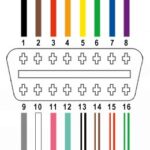The dreaded check engine light can be a source of anxiety for any driver. While the light itself doesn’t tell you much, understanding the diagnostic trouble codes (DTCs) it triggers can help pinpoint the problem. One common code is the Obd2 P0403. This article will delve into the P0403 code, explaining its meaning, potential causes, associated symptoms, diagnostic procedures, and common fixes.
Understanding the OBD2 P0403 Code
The P0403 code signifies a malfunction within the Exhaust Gas Recirculation (EGR) system, specifically the “Exhaust Gas Recirculation A Control Circuit.” The EGR system plays a crucial role in reducing harmful nitrogen oxide (NOx) emissions by recirculating a portion of exhaust gases back into the engine’s combustion chambers. This lowers combustion temperatures and minimizes NOx formation. When the P0403 code is triggered, it indicates a problem with the electrical control circuit of the EGR system, hindering its proper function. The Powertrain Control Module (PCM), your vehicle’s computer, monitors this circuit and sets the code when a fault is detected.
Common Causes of a P0403 Code
Several issues can trigger a P0403 code. These include:
- Faulty EGR Solenoid: The EGR solenoid controls the flow of exhaust gases into the intake manifold. A malfunctioning solenoid can disrupt this process.
- Defective EGR Valve: The EGR valve itself can become clogged with carbon deposits or fail mechanically, preventing proper gas flow.
- Wiring Issues: Damaged wiring or loose connections within the EGR control circuit can disrupt communication between the solenoid, valve, and PCM.
- Vacuum Leaks: In some systems, vacuum lines control the EGR valve. Leaks in these lines can prevent proper valve operation.
- Carbon Buildup: Excessive carbon buildup in the EGR passages can restrict gas flow and trigger the P0403 code.
- PCM Malfunction: While less common, a faulty PCM can also be the root cause of the problem.
Symptoms of a P0403 Code
Besides the illuminated check engine light, other symptoms might accompany a P0403 code:
- Rough Idle: The engine might run unevenly at idle.
- Poor Acceleration: Hesitation or sluggishness during acceleration can indicate an EGR issue.
- Engine Misfires: Misfires can occur, especially during startup.
- Increased Fuel Consumption: A malfunctioning EGR system can negatively impact fuel efficiency.
- Stalling: In severe cases, the engine might stall, particularly when the EGR valve is stuck open.
- Knocking or Pinging: Unusual engine noises might indicate problems related to combustion.
Diagnosing a P0403 Code
Diagnosing a P0403 code requires a systematic approach:
- Scan for Other Codes: Use an OBD2 scanner to check for other DTCs that might be related to the P0403 code.
- Review Freeze Frame Data: The OBD2 scanner can provide freeze frame data, capturing the engine conditions when the code was triggered.
- Inspect EGR Valve: Visually inspect the EGR valve for carbon buildup and clean it if necessary.
- Test EGR Solenoid: Check the EGR solenoid for proper electrical operation using a multimeter.
- Inspect Wiring and Connections: Examine the wiring harness and connectors for damage or looseness.
- Check Vacuum Lines: If applicable, inspect vacuum lines for leaks.
Fixing a P0403 Code
Once the diagnosis is complete, the appropriate repair can be performed:
- Replace EGR Solenoid: A faulty solenoid often needs replacement.
- Replace EGR Valve: A defective or severely clogged EGR valve should be replaced.
- Repair or Replace Wiring: Damaged wiring or connectors should be repaired or replaced.
- Repair Vacuum Leaks: Address any vacuum leaks in the system.
- Clean EGR Passages: Remove carbon buildup from the EGR passages.
- Replace PCM: In rare cases, PCM replacement might be necessary.
Conclusion
The OBD2 P0403 code indicates a problem with your vehicle’s EGR system. Understanding this code and its potential causes can help you address the issue effectively. While some fixes can be performed by DIYers, more complex issues often require the expertise of a qualified mechanic. Proper diagnosis and repair will ensure your vehicle runs efficiently and meets emissions standards. Remember to consult your vehicle’s repair manual for specific instructions and safety precautions.
